
STANLEY ROSEMAN
SPIRIT of the CLOWN
10. Christophe playing the Accordion
Paris, 1995
Oil on canvas, 120 x 100 cm
Collection of the artist
Paris, 1995
Oil on canvas, 120 x 100 cm
Collection of the artist
The Clown and Music
2. Anton, 1995
Derevo Company
Fata Morgana
Chalks on paper, 50 x 35 cm
Palais des Beaux-Arts, Lille
Derevo Company
Fata Morgana
Chalks on paper, 50 x 35 cm
Palais des Beaux-Arts, Lille
- Bibliothèque Nationale de France
Over successive evenings, after Christophe's performances at the theatre, he generously gave of his time to sit for Roseman. In the painting, Christophe wears white-face clown makeup, a voluminous red shirt, beige trousers, and a French cap called a gavroche.
In a biographical essay on Roseman, the Bibliothèque Nationale de France praises the artist's work on the subject of the clown:
© Stanley Roseman and Ronald Davis - All Rights Reserved
Visual imagery and website content may not be reproduced in any form whatsoever.
Visual imagery and website content may not be reproduced in any form whatsoever.
"Using the colors and textures of his oils, he has created paintings
that are both brilliant and moving portraits.''[3]
that are both brilliant and moving portraits.''[3]

''Resuming a thematic work from his youth, Stanley Roseman is again absorbed with the subject of the clown. Using the colors and textures of his oils, he has created paintings that are both brilliant and moving portraits.''*
- Bibliothèque Nationale de France
The Spirit of the Clown inspired Roseman again when he took up his oil paints and paper and chalks in Paris, where troupes of Italian players of the commedia dell'arte first performed in the sixteenth century at the invitation of Catherine de Médicis, an enthusiastic patroness of court divertissements and the new form of dance that came to be called "ballet.''[1] Over the following centuries, the comic characters of Harlequino, Pedrolino, Giglio, and Pulcinella assimilated into the French theatrical tradition. The Clown earned a respected place on the stage, in the circus ring, and in the music hall and became an important subject in French literature and art.
The catalogue Les Arts du Théâtre de Watteau à Fragonard, Musée des Beaux-Arts, Bordeaux, states that the art of the eighteenth century in France is "strongly identified with the world of the theatre," ("profondément marqués par l'univers du théâtre").[2] Artists depicted actors, dancers, singers, musicians, and characters of the commedia dell'arte: Harlequin, in his diamond-patterned costume; Gilles and Pierrot, dressed in white; and Polichinelle of Neapolitan ancestry, who became celebrated as the English Punch, the Spanish Pulchinella, the German Pulzinella, and the Russian Petrouchka.
Extended Family of the Commedia dell'Arte
An extended family of clowns of the present day have retained family traits from their illustrious forefathers while establishing their own comic identities in performances.
The Palais des Beaux-Arts, Lille, houses a renowned collection of master drawings from the Italian Renaissance, including an extensive holding of Raphael drawings, and drawings from the German, Flemish, Dutch, and French Schools, as exemplified by works from Poussin, Watteau, David, and Ingres to Géricault, Delacroix, and Matisse. The Curator of Drawings, Barbara Brejon de Lavergnée, acquired the drawing Anton along with four of Roseman's drawings of dancers of the Paris Opéra Ballet. (See website pages "On Drawing and the Dance," Pages 1 and 2 and "Biography,'' Page 2 - "World of Shakespeare.") The distinguished Curator of Drawings writes in a gracious letter, dated 13 May 1996, to Ronald Davis, who introduced his colleague's work to the Museum:
The Russian clown Anton with a long beak-of-a-nose, slender physique, and expressive body language is the subject of a marvelous drawing by Roseman in the Palais des Beaux-Arts, Lille, (fig. 2). Rendered with calligraphic strokes of the chalk and fine modeling of the facial features, the drawing reveals the clown's lineage from commedia dell'arte characters, as seen in Jacques Callot's celebrated suite of engravings entitled Balli di Sfessania, published in 1621 after the printmaker's departure from Italy and his return to his native city of Nancy, capital of the Duchy of Lorraine.
Roseman drew Anton Adasinsky, founder of the Derevo Company from St. Petersburg, in performances in Paris at the Ranelagh Theatre, whose administration had kindly given the artist the opportunity to draw from a loge during performances. The excellent clown troupe transported Parisian audiences to an imaginary Russian town called Fata Morgana, which gives its name to the theatre piece entitled Fata Morgana.
Through the nineteenth and twentieth centuries in France, the Clown appears in works by Daumier, Doré, Courbet, Degas, Manet, Cézanne, Seurat, Bakst, Léger, Rouault, Matisse, Picasso, and Chagall. Renoir painted a portrait of the English white-face clown John Price, and Toulouse-Lautrec depicted many famous actors, singers, and cabaret entertainers, as well as the Parisian clownesse Cha-U-Kao and the clown duo Footit and Chocolate, well-known to Parisian audiences at the music hall and the circus. Roseman's captivating models in their grease-paint makeup and fanciful costumes include youthful comic performers garnishing early recognition and celebrated clowns of his day. At the Paris Opéra, Roseman combined the subject of the clown and the dance with a series of superb drawings created at performances by star dancers Charles Jude and Kader Belarbi in the role of the Russian clown puppet Petrouchka. (See website page "Ballets Russes.")
- Barbara Brejon de Lavergnée
Curator of the Cabinet of Prints and Drawings
Palais des Beaux-Arts, Lille
Curator of the Cabinet of Prints and Drawings
Palais des Beaux-Arts, Lille
"The drawings that you so thoughtfully brought to us are superb. . . .
Please convey my congratulations to Monsieur Stanley Roseman for the great quality of his drawings.
We are proud to incorporate the work in our collection."
Please convey my congratulations to Monsieur Stanley Roseman for the great quality of his drawings.
We are proud to incorporate the work in our collection."
La Clownesse
The Musée d'Art Moderne et Contemporain, Strasbourg, conserves the masterly rendered portrait drawing of Elena Yarovaya, (fig. 6), a talented young Russian comedienne and member of the Derevo Company that presented Fata Morgana in 1995 at the Ranelagh Theatre.
The portrait, at once humorous and poignant, depicts Elena in profile, her head back, a large bow on top of her head. With calligraphic lines of bistre chalk, Roseman describes the bow and frilly collar complemented by the artist's painterly use of the chalks in rendering Elena's face and slender neck. The blending of sanguine chalk for the rouge make up around her eyes and her chalky white complexion enhance Elena's expression as she lifts her thin eyebrows and displays a toothy grin to her admirers.
6. Elena, 1995
Derevo Company
Fata Morgana
Chalks on paper, 50 x 35 cm
Musée d'Art Moderne et Contemporain, Strasbourg
Derevo Company
Fata Morgana
Chalks on paper, 50 x 35 cm
Musée d'Art Moderne et Contemporain, Strasbourg
At the Théâtre le Ranelagh
Writing about his work in Paris on the subject of the clown, Roseman recounts:
"The apartment building in which I lived was a few blocks from the landmark Théâtre le Ranelagh near the Ranelagh Gardens in the Passy district in a western quarter of Paris. The Ranelagh Theatre traces its history to the mid-eighteenth century, when Alexandre Joseph de La Pouplinière, farmer general to Louis XV, built a theatre at his residence the Château de Boulainvilliers, the future site of the Ranelagh Theatre. La Pouplinière was a great patron of the arts and brought together at the château renowned musicians, writers, and artists, including the musical dramatist Rameau; the man of letters Voltaire; and the painter Carle Van Loo, whose oeuvre includes a depiction of the commedia dell'arte character Polichenelle.
"The theatre and château were destroyed in the aftermath of the French Revolution. In the late nineteenth century, the automobile manufacturer Louis Mors, who was also an enthusiastic patron of music and opera, acquired a parcel of the former Boulainvillers estate. Mors commissioned and had built in 1893-94 a new theatre with a beautiful, oak-paneled auditorium in the Flemish Renaissance style. By the early 1930's, stage performances at the Ranelagh had given way to cinema, and the theatre had become one of the leading movie houses in Paris. The Ranelagh Theatre regularly screened Marcel Carné's Les Enfants du Paradis, the French film classic from 1945 about the mime Deburau, celebrated in the nineteenth-century for his portrayal of Pierrot.
"The Ranelagh Theatre returned to presenting stage shows under its new Administration in 1985. During the time I was drawing the dance at the Paris Opéra, I was invited to draw at the Ranelagh Theatre, which was presenting a number of shows featuring clowns. The Administration kindly provided me with my own loge on each side of the stage from where I had the possibility to draw from alternating perspectives during successive performances."
3. Stanley Roseman drawing from a loge in the landmark Ranelagh Theatre, Paris, 1995.
The theatre's administration kindly provided Roseman with a loge on either side of the stage from where he drew the clowns at performances.
Roseman's drawings depict a variety of clown personalities, such as the excellent troupe of French clowns who cavort in the misadventure Tout peut arriver ("Anything Can Happen''). The players include the auguste clowns Frank, the leader of the troupe; the endearing Bruno, with his big red nose, tousled brown hair, and engaging smile; the comically alluring Trex, in travesty; and the aristocratic white-face clowns Eric and Philippe in top hats and frock coats.
Sur la route de Sienne
Sur la route de Sienne, a fanciful, pantomimic adaptation of Shakespeare's Romeo and Juliet, with the music of Prokofiev and Nino Rota, premiered at the Ranelagh Theatre in 1995 with an excellent cast of French and Russian clowns who were the inspiration for a series of beautiful drawings by Roseman. Sur la route de Sienne combined elements of the circus and the commedia dell'arte. The co-author of the show, Valery Keft, a tall, striking, white-face clown, led the troupe of comic players "on the road from Siena,'' where an early version of the famous story of the star-crossed lovers was written in the fifteenth century. Valery Keft's compatriot in the show was Kassya, both of whom were from the noted Litsedeyi clown company in St. Petersburg. Kassya, a classic, European white-face clown, stood alone in a spotlight on the darkened stage and opened the performances of Sur la route de Sienne.
The Musée des Beaux-Arts, Bordeaux, conserves the superb drawing Kassya, (fig. 4). A fascinating clown personage, Kassya wears a white conical hat and ruff and an elegant black and silver costume. With fluent strokes of black chalk, Roseman depicts Kassya in a graceful movement as he turns towards the audience. The artist's chiaroscuro modeling of the expressive face and tall hat with warm shadows and cool highlights adds drama to the image of the clown who seems to emerge from the spacial dimension of the paper.
Kassya complements the Bordeaux Museum's earlier acquisition of Roseman's portrait painting Frosty Little, Director of Clowns of the Ringling Bros. and Barnum & Bailey Circus. (See "Spirit of the Clown," Page 1.) The Museum also conserves Roseman's drawings on the monastic life, as well as a suite of the artist's drawings from Jean Genet's The Balcony presented by the Classic Stage Company, New York City.
4. Kassya, 1995
Sur la Route de Sienne
Chalks on paper, 50 x 35 cm
Musée des Beaux-Arts, Bordeaux
Sur la Route de Sienne
Chalks on paper, 50 x 35 cm
Musée des Beaux-Arts, Bordeaux
Francis Ribemont, Chief Curator of Patrimony of the Musée des Beaux-Arts, Bordeaux, writes in a gracious letter to Roseman to acknowledge the Museum's acquisition of Kassya and drawings of Paris Opéra star dancers Fanny Gaïda in La Bayadère and Elisabeth Maurin in Romeo and Juliet:
- Francis Ribemont
Chief Curator of Patrimony
Musée des Beaux-Arts, Bordeaux
Chief Curator of Patrimony
Musée des Beaux-Arts, Bordeaux
"The Musée des Beaux-Arts of Bordeaux is very honored by the donation of three of your drawings:
Kassya, 1995, Fanny Gaïda, 1996, and Elisabeth Maurin, 1995,
that you have generously offered. They enrich the collection of 20th century drawings
that are conserved in the museum and constitute with the series of the Monks
and The Balcony by Jean Genet an ensemble of very great interest.''
Kassya, 1995, Fanny Gaïda, 1996, and Elisabeth Maurin, 1995,
that you have generously offered. They enrich the collection of 20th century drawings
that are conserved in the museum and constitute with the series of the Monks
and The Balcony by Jean Genet an ensemble of very great interest.''
The often quoted maxim of Ingres, "Drawing is the integrity of art,'' is taken to heart by Roseman, whose drawings constitute a major part of his oeuvre. The Musée Ingres, which houses an important bequest from the French master Jean-Auguste-Dominique Ingres (1780-1867) to his hometown of Montauban, acquired two of Roseman's drawings on the subject of the clown - "deux oeuvres superbes'' ("two superb works''), writes Georges Vigne, respected Ingres scholar and curator of the Musée Ingres.
From the collection of the Musée Ingres is Christophe, chalks on gray paper, 1995, (fig. 5). The French auguste clown Christophe, with his big red nose and mop of brown hair, provided a comic foil to the white-face clowns in Sur la Route de Sienne. A related drawing of Christophe, whom Roseman drew at a following performance, is in the British Museum, London. In the present work, with its dynamic interplay of lines and tones, the artist expresses emotion, gesture, and the physiognomy of his model. Roseman's excellent mise-en-page in composing his work captures the feeling of movement in the figure of Christophe trudging along, the burden of the world on his young shoulders.
5. Christophe, 1996
Sur la Route de Sienne
Chalks on paper, 50 x 35 cm
Musée Ingres, Montauban
Sur la Route de Sienne
Chalks on paper, 50 x 35 cm
Musée Ingres, Montauban
The Musée Ingres had made previous acquisitions of Roseman's work, which includes a chalk drawing of a Carthusian monk at Vigils and an oil on canvas portrait of a Trappist monk in meditation. The Museum also conserves Roseman's still life painting of small, wild apples entitled Les Pommes sauvages. (See website page "Biography,'' Page 8 - "Still Lifes.") Roseman's chalk drawings of the clowns were acquired with the Museum's acquisitions of three of his drawings in the medium of pencil from his extensive series on the dance at the Paris Opéra. (See website page "On Drawing and the Dance," and "Biography," Page 2 - "World of Shakespeare.'') In an enthusiastic letter to the artist, the curator writes:
"These two superb works will join the three works in pencil that you have also recently donated to us and we infinitely thank you for them."
- Georges Vigne
Curator
Musée Ingres, Montauban
Curator
Musée Ingres, Montauban
The incomparable Buffo is the celebrated clown personage of the American-born Howard Buten. At the performances in Buten's return engagements to great acclaim at the Ranelagh Theatre during the 1990's, Roseman created a series of superb drawings imbued with humor and pathos of the endearing clown Buffo.
Presented here, (fig. 7), is the drawing of Buffo in the Teyler Museum in the northern Dutch city of Haarlem. The Teyler Museum, founded in the eighteenth century and the oldest museum in the Netherlands, is renowned for its outstanding collection of old master drawings from the Italian Renaissance, including numerous sheets by Michelangelo and Raphael, and from the seventeenth-century Dutch School, notably drawings by Rembrandt.
The acquisitions in 1996 of Roseman's drawing of Buffo and a drawing of Paris Opéra star dancer Kader Belarbi as the noble Indian warrior Solor in Nureyev's last choreography La Bayadère complement the artist's drawings on the monastic life and other subjects previously acquired by the museum. (See website page "On Drawing and the Dance," Page 2 - "The Male Dancer.")
The Keeper of Prints and Drawings, Carel van Tuyll, writes in letter to Roseman that the museum is ''extremely grateful for the two beautiful drawings. . . . The Buffo (Howard Buten) is a wonderful and deeply felt portrait, while the line drawing of Kader Belarbi in 'La Bayadère' adds a whole new and exciting aspect to the representation of your work in the collection.''
7. Buffo, 1995
Chalks on paper, 50 x 35 cm
Teylers Museum, Haarlem
Chalks on paper, 50 x 35 cm
Teylers Museum, Haarlem
''The Buffo (Howard Buten) is a wonderful and deeply felt portrait''
- Carel van Tuyll
Keeper of Prints and Drawings
Teylers Museum, Haarlem
Keeper of Prints and Drawings
Teylers Museum, Haarlem
From his knowledge of the traditional types of clowns and having observed the application of clown makeup from his celebrated models at the Ringling Bros. and Barnum & Bailey Circus, Roseman designed a distinctive, white-face makeup for Alexandre. With brown eyes, accented by black eyeliner and complemented by blue eye shadow, Alexandre looks directly out from the canvas.
Alexandre transcends the painting's initial purpose to announce such a festive event as the First International Music Hall Festival. The dramatic stage lighting and the artist's chiaroscuro modeling of Alexandre's face, with strong lights and shadows, emphasize the young man's lean visage under his worn top hat. The smokey brown tones of the background contribute to a feeling of pathos in this magnificent portrait.
Under the High Patronage
of the French Ministry of Culture,
Roseman was commissioned to create a work for the poster announcing the First International Music Hall Festival,
Les Feux de la Rampe (Footlights), 1997.
of the French Ministry of Culture,
Roseman was commissioned to create a work for the poster announcing the First International Music Hall Festival,
Les Feux de la Rampe (Footlights), 1997.
Roseman chose as his model for his painting a young French performer named Alexandre and clothed him in semi-formal attire, with top hat and black bow tie, as the pictorial Master of Ceremonies.
Poster for the First International Music Hall Festival
Les Feux de la Rampe (Footlights), 1997.
Les Feux de la Rampe (Footlights), 1997.
Presented under the High Patronage
of the French Ministry of Culture.
of the French Ministry of Culture.
The poster features Roseman's painting
Alexandre, Paris, 1997
Oil on canvas, 50 x 50 cm
Collection of the artist
Alexandre, Paris, 1997
Oil on canvas, 50 x 50 cm
Collection of the artist
The portrait Elena entered the Strasbourg Museum of Modern and Contemporary Art along with four of Roseman's drawings on the dance at the Paris Opéra. Rodolphe Rapetti, Curator of Patrimony and Director of the Museums of Strasbourg, later appointed Chief Curator of Patrimony and Deputy Director of the Museums of France; and Anny-Claire Haus, Curator of the Cabinet of Prints and Drawings of Strasbourg, write in a cordial letter to Ronald Davis, who introduced his colleague's work to the museum:
''You have presented the Cabinet of Prints and Drawings of the Museums of Strasbourg with an ensemble of five drawings of great quality by Stanley Roseman. . . .
"These remarkable portrayals of dancers of the Paris Opéra Ballet and of an actress drawn at the Ranelagh Theatre integrate quite naturally in the suite of our prestigious series of works by Bakst and Rodin and enrich in a wonderful way the collection of the Cabinet of Prints and Drawings.''
- Rodolphe Rapetti
Curator of Patrimony
Director, Museums of Strasbourg
Deputy Director, Museums of France
Curator of Patrimony
Director, Museums of Strasbourg
Deputy Director, Museums of France
- Anny-Claire Haus
Curator
Cabinet of Prints and Drawings
Museums of Strasbourg
Curator
Cabinet of Prints and Drawings
Museums of Strasbourg
Theatre, Circus, and Music Hall
Buffo at the Théâtre le Ranelagh
Cirque de Paris
8. Stanley Roseman drawing Christophe at the Cirque de Paris, 2003.
Music Hall - Slava at the Casino de Paris
Clowns and music have a centuries-old association. Roseman's work on the subject of the clown includes depictions of clowns at their music, as with the superb oil on canvas portrait Christophe playing the Accordion, 1995, (fig. 10, below). The French clown Christophe was one of the talented players Roseman drew in Sur la route de Sienne at the Ranelagh Theatre.
The eminent Slava Polunin, from St. Petersburg, thoughtfully invited Roseman to draw during performances of the Russian clown's acclaimed world-touring Snow Show, presented for the holiday season of December 2000 to January 2001 at the Casino de Paris.
Slava Polunin, founder of the Litsedeyi clown troupe in St. Petersburg, was a mentor to a following generation of clowns, including Anton Adasinsky, (fig. 2); Valery Keft, co-author of Sur la route de Sienne; and Kassya, (fig. 4).
At the Casino de Paris, Roseman created impressive drawings of Slava, as with the present work that beautifully depicts the clown in profile, his head inclined as he moves across the spacial dimension of the paper, (fig. 9). Slava's large, bulbous, red nose dominates his expressive face with a greasepaint beard darkening his cheeks and chin. Roseman's painterly use of black chalk combines broad, descriptive strokes and fine, detail modeling. Passages of yellow pastel suggest Slava's signature yellow costume and add a bright note of color to this poignant and introspective portrayal of the eminent clown in his advancing years.
The famous Parisian music hall Casino de Paris dates back to the nineteenth century and counts among its illustrious performers Mistinguett, through the first quarter of the twentieth century; Maurice Chevalier, from the mid-1920's; Josephine Baker, in the 1930's; Line Renaud, in the late 1950's to the 1960's; Zizi Jeanmaire, in the 1970's; and Slava, at the turn of the twenty-first century.
9. Slava, 2000
Casino de Paris
Chalks and pastel on paper, 50 x 35 cm
Private collection, France
Casino de Paris
Chalks and pastel on paper, 50 x 35 cm
Private collection, France
From Roseman's recollections about his work on the subject of the clown is a brief excerpt here about visiting his friend Christophe at the Cirque de Paris. The artist had drawn the clown in Sur la route de Sienne at the Ranelagh Theatre in the mid-1990's, (fig. 5, above), and at that time painted a portrait of him in clown makeup and playing the accordion, (fig. 10, below).
"Christophe thoughtfully gave us a tour of the compound and introduced us to some of the performers in that familial circus environment.
"The day was warm and sunny with a gentle breeze. Christophe sat outdoors at a dressing table by the entrance to the small tent near the circus wagons and trailers, and I drew him applying makeup for his clown personage in preparation for the show. With my drawing book and box of chalks, I accompanied Christophe into the main tent where I drew him performing in the circus ring to a delighted audience. That memorable time at the Cirque de Paris brought back wonderful memories of my sojourns with the Ringling Bros. and Barnum & Bailey Circus some twenty-five years before."
The Theatre has provided Roseman with continuing inspiration for his work on the subject of the clown. At the Ranelagh Theatre in 1997, the Micos clowns, a troupe of talented performers from Moscow, made their first appearance in Paris. Roseman created a series of wonderful drawings of Nicolai, Mikhail, Paganel, Sergei, and Kotini - all captivating personalities - in a show of musical and humorous vignettes. Street theatre is also represented in Roseman's work. The artist's suite of drawings of the German mime Ilka depict her performing in Paris in 1995 in the square by the Church of St. Eustache in the First Arrondissement and in the Tuileries Garden. The Musée Ingres' acquisitions of Roseman's work include a superb chalk drawing of Ilka.
Reaching back to ancient Greek comedy is the farce Le Chevalier, after Aristophanes, performed by an excellent cast during the 1996 Paris Summer Festival, which presented musical and theatrical events throughout the City. At performances given in the Musée National du Moyen Age - Thermes de Cluny, Roseman drew the noted Croatian actor Mladen Vasary. The impressive drawing Mladen, in the British Museum, London, exemplifies the actor's comic stage personage reminiscent of characters from the commedia dell'arte.
The Theatre
"In June 2003, Ronald and I visited Christophe at the Cirque de Paris, an intimate circus located in a wooded compound on the outskirts of Paris, in Villeneuve-la-Garenne. Christophe had thoughtfully made a request to the administration, who graciously extended an invitation to us and for me to draw at the circus. The small village-like setting comprised old circus wagons; modern trailers; a menagerie; several low buildings; a small, circus tent; a beautiful carousel from the early 1900's; and the main tent that rose high above the circus grounds.
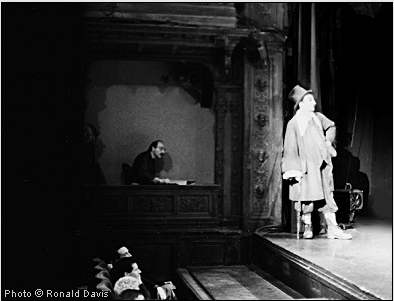
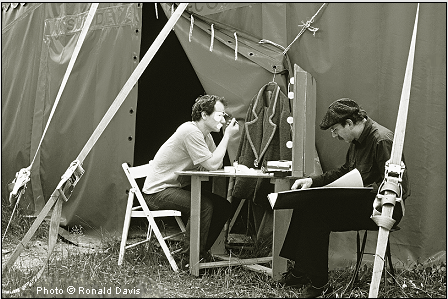
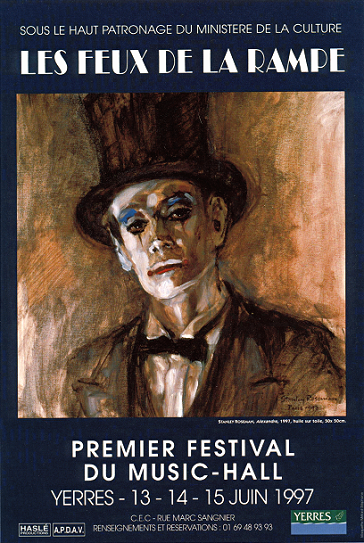
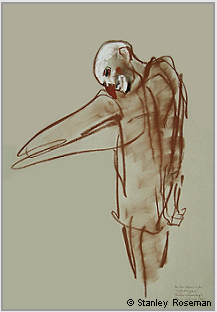
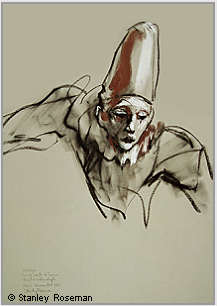
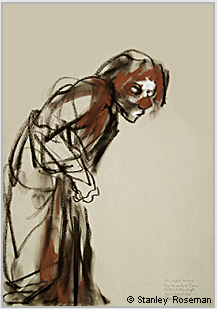
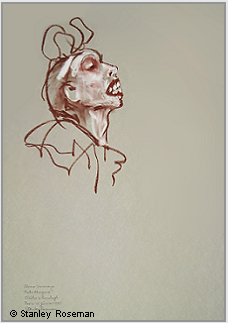
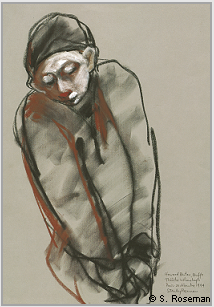
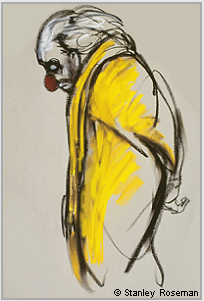
* Stanley Roseman - Dessins sur la Danse à l'Opéra de Paris - Drawings on the Dance at the Paris Opéra,
(text in French and English), (Paris: Bibliothèque Nationale de France, 1996), p. 11.
1. Pierre Louis Ducharte, The Italian Comedy, (NewYork: Dover Publications, 1966), p. 20.
2. Marianne R. Michel and Daniel Rabreau. Les Arts du Théâtre de Watteau à Fragonard,
(Bordeaux: Musée des Beaux-Arts, 1980), p. 43.
3. Stanley Roseman - Dessins sur la Danse à l'Opéra de Paris, Bibliothèque Nationale de France, p. 11.
(text in French and English), (Paris: Bibliothèque Nationale de France, 1996), p. 11.
1. Pierre Louis Ducharte, The Italian Comedy, (NewYork: Dover Publications, 1966), p. 20.
2. Marianne R. Michel and Daniel Rabreau. Les Arts du Théâtre de Watteau à Fragonard,
(Bordeaux: Musée des Beaux-Arts, 1980), p. 43.
3. Stanley Roseman - Dessins sur la Danse à l'Opéra de Paris, Bibliothèque Nationale de France, p. 11.
Biography: Page 4
Continued
Continued
Please note that the website has been republished for Internet Explorer 11.
Christophe had studied science and music, but his interests in the circus led him to circus schools in Paris and Grenoble, where he trained as an acrobat, juggler, and clown.
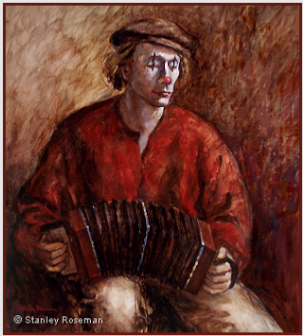
The portrait is imbued with earth colors of umber and sienna. Christophe is seated holding his accordion on his right knee. With chiaroscuro modeling the artist has rendered the clown's face with cool highlights and warm shading. In this intimate composition the clown, with eyes closed, is immersed in thought and in his music.